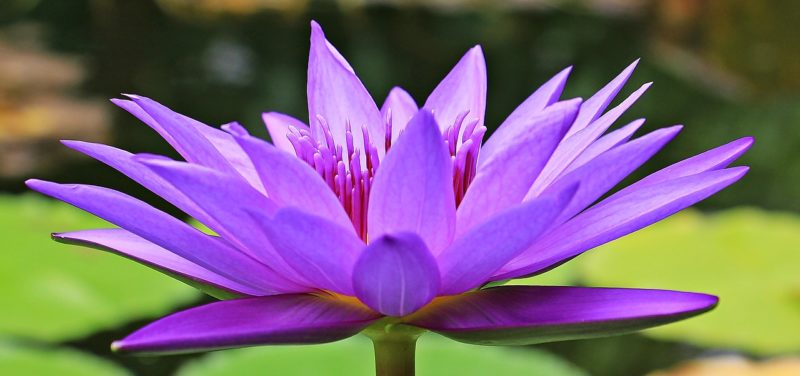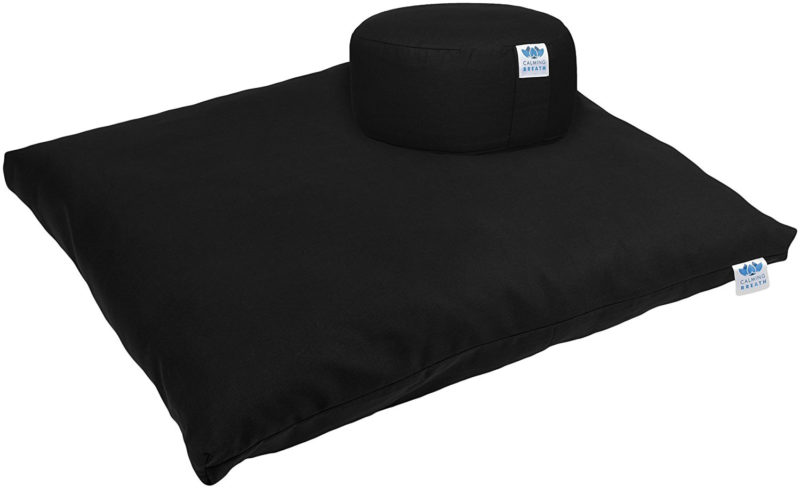
I’ve been meditating in various forms since my teenage years, albeit with many on and off periods. Lately, I seem to have found a style that suits me very well, and I’ll be sharing some background on that today.
Essentially, I’ll be describing zazen meditation.
Zazen is primarily a seated type of meditation. There are several types of meditation, including ones that involve walking or even lying down. Zazen is considered the heart of Japanese Soto Zen Buddhist practice.
The aim of zazen is that of suspending all judgmental thinking and letting words, ideas, images and thoughts pass by without getting involved in them. Of course, all this is done while being immersed in sitting meditation.
In Zen temples and monasteries, practitioners traditionally sit zazen as a group in a meditation hall, usually referred to as the zendo. The practitioner sits on a cushion called a zafu, which itself is usually placed on top of a low, flat mat called a zabuton.
Before taking one’s seat, and after rising at the end of the period of zazen, a Zen practitioner performs a gassho bow to their seat, and a second bow to fellow practitioners.
The beginning of a period of zazen is traditionally announced by ringing a bell three times (shijosho), and the end of a round by ringing the bell either once (houzensho).
Long periods of zazen may alternate with periods of kinhin (walking meditation). In such cases the bell sequence will be a bit more elaborate than what I just described:
- Three rings to start zazen
- Two rings to end zazen and start kinhin
- One ring to end kinhin
- Three rings to start zazen again
- One ring to end zazen
If you go to a zazen meditation center you will most likely take part in a longer session that will be punctuated by breaks of walking meditation, so you will hear the bell sequence I just described.
There is no need to use music while practising zazen meditation. It’s not common to have any background music at the zendo. At home, you are free to use whatever works for you.
This practice might seem difficult, but daily practice is very effective in increasing your sense of self-awareness and intuition. While the practice of zazen typically awakens a certain energy and sense of wakefulness in us, there is no need to set any objectives or aims to achieve anything. It simply consists of concentrating on the posture and the breathing as well as the mind and the thoughts it gives rise to.
You will need a zafu and zabuton, as we already mentioned. These can easily be found on Amazon. Here’s a picture of the Calming Breath set I got; I’m very happy with them. The zafu also doubles as a foot rest while working, which is great.

Let’s take a deeper look at each of these three pillars of zazen meditation:
Posture
Sit on the zafu (cushion) cross legged, with the zabuton beneath you for comfort.
There are several poses you can use:
- Full Lotus
- Half Lotus
- Burmese

Full Lotus pose
If you can sit in Full Lotus without serious pain, then it is by far the most stable of all the cross-legged postures.
Place one foot on top of the opposite thigh then lift your other foot up onto its opposite thigh. The soles of your feet should be facing slightly upward and outward. If you experience pain, try going back to one of the easier postures while you continue to work on your mobility for this pose.

Half Lotus pose
Many people who cannot manage Full Lotus can sit quite comfortably in Half Lotus.
Place one foot on top of the opposite thigh. Your other foot should be resting on the floor just under the opposite thigh/knee. Try it both ways. You may find that one side is considerably easier than the other. If that’s the case, then consider some yoga stretches to work on the imbalance so that eventually you can alternate sides and work on Full Lotus.

Burmese pose
The Burmese Pose is ideal for those who aren’t flexible enough to comfortably stay in the Lotus poses. For this reason, it’s currently my preferred pose for meditation.
Put the sole of one foot against the inside of the opposite thigh. Put the sole of the other foot against the shin of the opposite leg. All of both your legs and feet should be in contact with the floor. It’s not an easy position but does offer a really stable platform for those that can manage it.
The weight of the body is placed on three points: the knees pushing against the ground and the perennial muscle which presses against the zafu. The spine is straight and vertical. The back is flexed, and the shoulders are relaxed. The chin is tucked in, the back of the neck is stretched. Push the top of your head up towards the sky. The mouth is closed and the tongue touches the upper palate and the inside of the two front teeth. This calms “interior chatting”. The eyes are half-closed and look down towards the ground, about one meter in front, without focusing on anything in particular.
Breathing
The rhythm of the breath is very important in zazen meditation.
Breathe calmly through the nose, remaining totally conscious of it, meaning being attentive to each breath, like a tiger on the watch. Breathe naturally and breathe out calm, long, deep breaths all the way under the navel. Don’t judge your breathing – if it’s slow or rapid – it is just the way it is.
Little by little, with practice, breathing out becomes soft, slow, peaceful, long and deep; pushing the abdominal mass downwards and creating a concentration of energy in the zone which is called the kikai tanden (ocean of energy) located under the navel. At the end of the breath, breathing in is done naturally.
State of Mind
Once you have the right posture and the breathing rhythm in place, you can start noticing your state of mind. In the first practices of zazen you will most likely get distracted easily, and you will have many thoughts going on. Once you settle into the practice, however, you will notice that you start to take control over your mind and you start to adopt a stronger, more centered state of mind.
At the end of the day, Zen is very simple, but at the same time very hard to comprehend. It’s a question of struggling and practicing repeatedly, much like life itself. In this seated position of zazen, without doing anything special and expecting nothing in return, if our posture, our breathing, and our mental attitude are in harmony, we will begin to understand the authentic Zen.
If you don’t feel comfortable with zazen, I would recommend that you adopt the pose itself and use a more mainstream kind of meditation. You can use apps like Calm or Headspace for example, which are excellent introductions to the practice of meditation.
Whenever I want to do a quick meditation I still revert to Calm. For example, at times when I don’t have time to do a full zazen meditation session, I’ll just pop in my noise canceling earphones and use Calm to do a 15-minute meditation. You don’t even need a mat for that, you can do it sitting down anywhere.
Further reading and viewing:
A five-minute instruction introducing the correct positioning and breathing for the Zazen style of meditation:
A ten-minute zazen session:
A longer explanation of Zazen and posture:
An introduction to meditation in general, including why it’s beneficial and how to make it a daily habit:
Dealing with Irritation

By nature, I’m quite easily irritated and frustrated, and I am constantly working on improving this part of myself. I know exactly how it feels and how it manifests in my body. I clench my teeth, I can feel my heart beating rapidly, my legs get restless, and everything else in the world seems to fade away as my whole being zooms in on the discomfort and injustice of the situation. It’s a dark place to be in and not conducive to any good result especially when interacting with people.
This sense of irritation and frustration is easily triggered, but a very typical trigger is when I have to call customer service for any big company. Here’s a recent one from when I had to call my bank. As usual, I had to navigate my way through a series of automated questions and subsequent questions, which is enough to trigger some frustration and “don’t waste my time” feeling. Add to that the fact that I was calling due to a mistake the bank had made with my account, so I was already charged going into the call. As I was put on hold and left alone with the elevator music, I noticed stress in my stomach and tension in my body. I stopped, realizing this irritation felt familiar. I know I have this tendency to get frustrated and I didn’t want to strengthen it.
It was an opportunity to tap into my practice. So I took a few deep breaths and helped my mind and body relax. I made a commitment to myself that when the customer rep would come on the phone I would express no irritation and treat them warmly. When she asked if I was having a nice day, instead of projecting my irritation, I said “I am, thanks. How are you?”. The conversation then proceeded calmly, it was indeed their mistake and I had to explain what happened, wait until I was put on hold for a few more minutes, and then have them acknowledge the mistake and rectify it. In this situation there was nothing I could do to influence things, they made a mistake and it needed to be fixed, following all their standard procedures. The only factor I had under my control was my response before and throughout the conversation.
Since this is a challenging scenario for me, when I hung up the phone I had a sense of triumph. If we remain grounded and mindful in situations where we can easily become irritated, even if we don’t get what we want we release the stress and irritation that we are carrying. To me, that in itself is a victory. The way Thich Nhat Hanh describes it is that every feeling is a field of energy; a pleasant feeling is a feeling that can nourish, irritation is a feeling that can destroy. Under the light of awareness, the energy of irritation can be transformed into an energy which nourishes. So basically, our choices directly strengthen the qualities within us. If we practice patience, we strengthen patience. If we get swept away by irritation, we strengthen irritation.
It’s up to us which quality we wish to strengthen.
Building Resilience

During a recent session of meditation I came across this insightful quote by the 8th-century Indian Buddhist monk Shantideva:
Where could I possibly find enough leather to cover the surface of the thorny earth?
Yet leather on the soles of my shoes is as good as covering the entire earth.
Likewise it is not possible for me to restrain the external course of things.
But if could I restrain this mind of mine why would I need to restrain all else?
Too many times we get angry and distressed at what’s happening around us. To be sure, we are never going to be short of things to pick on in this crazy world that we live in.
Shantideva tells us that it is hopeless to try and control the many aggravations of our daily lives. Yet is it possible to change our way of experiencing life instead?
Of course it is! Life is a subjective experience. As I think about this quote, I remember my 93 year old grandmother, who maintains an incredibly positive and cheerful state whatever comes her way.
She’s lived through the Second World War and the early death of her husband amongst many other hardships, but I can’t recall a single time when I found her in an angry, stressed or depressed state.
Unfortunately I haven’t inherited her natural gift of defaulting to having a positive outlook on the world around us, but I know through experience that I can continuously retrain the mind to achieve the same state.
Daily meditation is an essential tool for this purpose. It builds awareness and helps increase our resilience to the challenges and obstacles that we encounter.
Meditation helps remind me of the impermanence of things; the natural ebb and flow of life. It’s a great way to culture feelings of forgiveness, love, and kindness toward the world and fellow humans.
If you have never meditated or have not made it a daily practice, I highly encourage you to do so. For help in getting started, you can check out my favorite meditation app: Calm.

The pictures showing no contact between the hands while meditating is not proper positioning for zazen. Hands must be together one on top of the other with palms facing up.
Just saying (at least for Soto school).
You’re right, I used a stock image for meditation that is not specific to Zazen. Thanks for pointing it out.
This video from Eshu is wonderful, after watching this I started listening to some of his audios on an old podcast. Great material for a zen learner there. 🙂 Thanks for sharing!
do you practice zazen with someone here in Malta?
I am looking for a group that is why I am asking.
Thanks
No Karl, I practice it in Spain. Let me know if you find anyone doing it in Malta, would be interesting to know.
Hi! I practice zazen at home in Malta and came across your blog post and the comments. Curious to know if you have encountered anyone else in Malta who sits since you wrote this. Thanks.
Awesome that you practice it too. I don’t live in Malta so I wouldn’t be able to help unfortunately.